A resource from our Summer Reading Clinic
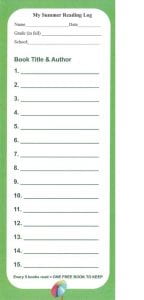 These reading logs are a great way to keep students practicing their reading skills throughout the summer!
These reading logs are a great way to keep students practicing their reading skills throughout the summer!
Students need to know that reading does not stop because school is out for the summer. Give these sheets to your students before the end of the year. Tell them they will be posted when they return in the fall. Have a cornucopia of books for them to access over the summer. Make arrangements with your local library to have a stack of the logs available.
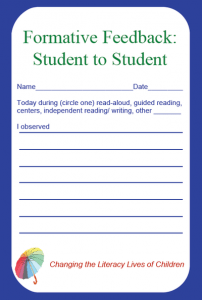 William, (2011) defines formative feedback with the following: Feedback functions formatively only if the information fed back to the learner is used by the learner in improving performance. If the information fed back to the learner is intended to be helpful but cannot be used by the learner in improving performance, it is not formative. Feedback must embody a model of progression whereby a series of activities must be designed to move the learner from current state to goal state. We need to ensure that feedback causes a cognitive rather than an emotional reaction. (It is not a compliment or a criticism). The purpose of feedback should be to increase the extent to which students are owners of their own learning.
William, (2011) defines formative feedback with the following: Feedback functions formatively only if the information fed back to the learner is used by the learner in improving performance. If the information fed back to the learner is intended to be helpful but cannot be used by the learner in improving performance, it is not formative. Feedback must embody a model of progression whereby a series of activities must be designed to move the learner from current state to goal state. We need to ensure that feedback causes a cognitive rather than an emotional reaction. (It is not a compliment or a criticism). The purpose of feedback should be to increase the extent to which students are owners of their own learning.
Student to student feedback is important. Teach your students how to comment constructive about their peers work. Teacher must model, demonstrate, and explain student to student feedback and provide examples. Be explicit about what is allowed on the feedback and what is not appropriate. Have students read their feedback and discuss if they agree or not and why. Ask if they would change anything after reading feedback.
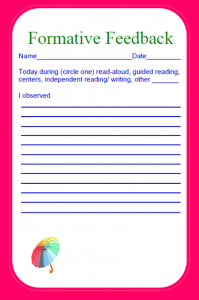 Allows teachers to record observations of students’ literacy skills during class and provide feedback for students and parents.
Allows teachers to record observations of students’ literacy skills during class and provide feedback for students and parents.
Formative assessment and feedback needs to be ongoing and continuous if you are measuring the developmental level of a student with fidelity. These pads can be used to include anecdotal information, quick assessment checks, observations, concerns, etc. You may want to send one home to a
parent (make and keep a copy for your files) acknowledging a student’s fine contribution or perhaps a friendly note to have them work on a particular skill with their child.
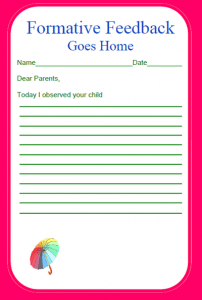
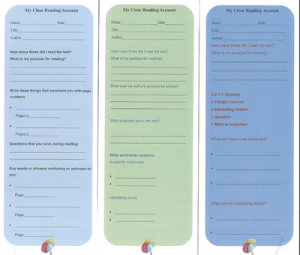 These forms guide students in documenting and becoming more aware of their close reading skills. Forms are available in three levels: Primary (Dark Blue), Intermediate (Green) & Upper Grades (Light Blue). In response to the need to shift instructional strategies to highlight close reading, we have developed a close reading kit which includes the three levels of reading forms. This kit grew out of concern about how to document students’ close reading and is meant to be an active tool that students use during guided reading, independent reading and writing, and in the language and literacy centers.
These forms guide students in documenting and becoming more aware of their close reading skills. Forms are available in three levels: Primary (Dark Blue), Intermediate (Green) & Upper Grades (Light Blue). In response to the need to shift instructional strategies to highlight close reading, we have developed a close reading kit which includes the three levels of reading forms. This kit grew out of concern about how to document students’ close reading and is meant to be an active tool that students use during guided reading, independent reading and writing, and in the language and literacy centers.
My Close Reading Account Intermediate Level
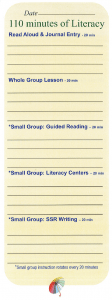 Used by the teacher to plan their daily Balanced Literacy activities; can be posted outside the classroom for public disclosure.
Used by the teacher to plan their daily Balanced Literacy activities; can be posted outside the classroom for public disclosure.
Teachers have commented, “These pads have saved my time management problems”, “I feel secure in knowing I am accomplishing my literacy goals for the day and the week”; “I could have used these years ago.” These pads are to be used to help you plan your literacy block and make your teaching transparent. Fill out one each day and you will immediately notice that your planning has become intentional. Choose and pre-read your Read Aloud , prepare your questions in a scaffolding manner and require students to journal every day. The very young ones can draw and label what their thoughts are. Post these slips where they can be seen by your administrators.
 The Exit Slips are to be used for larger units of thought including ideas, notions, images, and much more, which allow for richer conversations and discussions to ensue. There are four downloadable exit slips covering each area of formative assessment: Read-aloud, Centers, Guided Reading, and Independent Reading and Writing. There is also a convenient 4-in-1 sheet available for download.
The Exit Slips are to be used for larger units of thought including ideas, notions, images, and much more, which allow for richer conversations and discussions to ensue. There are four downloadable exit slips covering each area of formative assessment: Read-aloud, Centers, Guided Reading, and Independent Reading and Writing. There is also a convenient 4-in-1 sheet available for download.
Want to know what questions your students had but didn’t ask in class? Interested in finding out what concepts students understood in class? Always have exit slips available. These “parking lot” tools help you group your students for small, differentiated learning. Collect the slips and sort them according to levels of understanding. You may discover that you need to “circle back” and answer questions. Or, move more quickly. Exit slips are a quick way of ascertaining the learning that is going on.
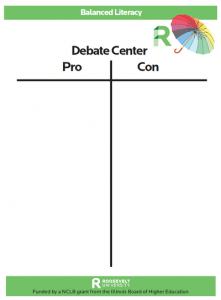 The debate center is one strategy in which to promote the development of argument and debate. This center can remain up all year in classrooms while changing the topic of debate on a weekly basis. Social justice can be the perfect starting point as students work on teams to develop opinions and arguments to debate. Students at centers are engaged in rigorous conversations based both on the informational text readings and their own personal experiences.
The debate center is one strategy in which to promote the development of argument and debate. This center can remain up all year in classrooms while changing the topic of debate on a weekly basis. Social justice can be the perfect starting point as students work on teams to develop opinions and arguments to debate. Students at centers are engaged in rigorous conversations based both on the informational text readings and their own personal experiences.
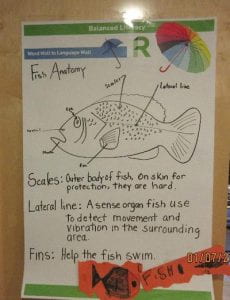 Language Walls are Word Walls expanded to a more sophisticated level to include ideas, notions, images, and much more, providing for deeper discussions. Language walls foster both social and academic discourse, allowing the teacher to document specific aspects of language. These walls allow for building vocabulary in all content areas. The focus of a language wall is on language generation by the students which create new information and understanding about the world.
Language Walls are Word Walls expanded to a more sophisticated level to include ideas, notions, images, and much more, providing for deeper discussions. Language walls foster both social and academic discourse, allowing the teacher to document specific aspects of language. These walls allow for building vocabulary in all content areas. The focus of a language wall is on language generation by the students which create new information and understanding about the world.
Check out the Word Walls to Language Walls article by Dr. Margaret Policastro for more information.